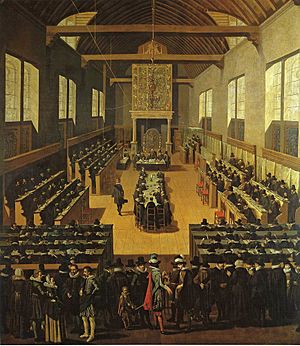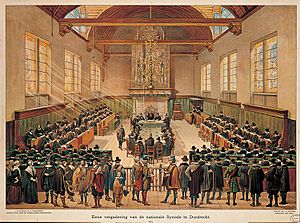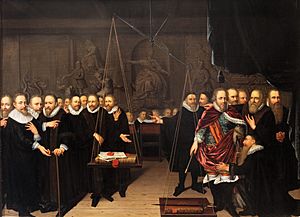Synod of Dort facts for kids
The Synod of Dort was a big meeting held in the city of Dordrecht in the Netherlands between 1618 and 1619. It was organized by the Dutch Reformed Church. The main goal was to solve a major disagreement about religious ideas, especially those of a group called the Arminians.
This important meeting brought together church leaders and thinkers from the Netherlands and other countries. They met for many months to discuss and decide on key points of their faith.
Contents
What Was the Synod of Dort?
The Synod of Dort was like a large church council. It gathered leaders from the Dutch Reformed Church and invited representatives from eight other Reformed churches across Europe. The first meeting was on November 13, 1618, and the last, the 180th, was on May 29, 1619.
The name "Dort" was a common way to say "Dordrecht" back then. This meeting was very important for the history of the Reformed faith.
Why Was the Synod Held?
The Big Debate: Arminians vs. Calvinists
The main reason for the Synod was a big argument within the Dutch church. This argument started after a professor named Jacob Arminius passed away. His followers, known as the Arminians or Remonstrants, had different ideas about some parts of the Christian faith. They wrote down their ideas in a document called The Remonstrance of 1610.
The Arminians believed:
- People choose to believe in God (conditional election).
- God's love is for everyone (unlimited atonement).
- People can choose to say no to God's grace (resistible grace).
- It's possible to lose your faith after you've found it (possibility of lapse from grace).
On the other side were the Contra-Remonstrants or Calvinists. They followed the teachings of John Calvin and Theodore Beza. Their leader was Franciscus Gomarus. They disagreed strongly with the Arminians' ideas.
Political Tensions
This religious debate also got mixed up with politics. The Netherlands was in a long war with Spain, called the Eighty Years' War. There was a break in the fighting called the Twelve Years' Truce. During this time, some people thought the Arminians were too willing to compromise with Spain. This made the religious disagreement even more intense, as some saw Arminian ideas as not just wrong beliefs but also a risk to the country.
Who Attended the Synod?
Many important people came to the Synod of Dort. Besides the Dutch church leaders, there were delegates from other Reformed groups. These included representatives from the Church of England and the Church of Scotland. This showed how important the debate was across Europe.
How the Meetings Happened
The Arminians, led by Simon Episcopius, were called to present their views. Episcopius wanted to start by explaining why he disagreed with the Calvinist ideas. However, the Synod leaders said that since the Arminians were accused of changing the faith, they needed to first show proof from the Bible for their own beliefs.
The Arminians did not agree with this way of doing things. Because of this, they were eventually asked to leave the Synod. After they left, the Synod continued its discussions without them.
The Canons of Dort
The Synod of Dort ended by rejecting the Arminian views. Instead, it clearly explained the Reformed beliefs on the debated points. These beliefs are often called the Five points of Calvinism. They are:
- Total Depravity: This means that sin affects every part of a person.
- Unconditional Election: This means God chooses people for salvation based on His own will, not on anything they do.
- Limited Atonement: This means that Jesus's death on the cross was specifically for those God chose.
- Irresistible Grace: This means that when God calls someone, they cannot resist His grace.
- Perseverance of the Saints: This means that those God has chosen will continue in faith until the end.
These five points are summarized by the acronym TULIP in English. The official document explaining these decisions is called The Canons of Dort. It explains both the true view that agrees with God's word and the false view that does not.
What Happened After the Synod?
After the Synod, the Arminian ministers who had attended were told to stop their church activities. They were asked not to preach or teach their ideas. When they refused to stop, they were seen as causing trouble for the public. Many were ordered to leave the Netherlands.
However, Arminian ideas later spread to other countries, like England. They became very important in the development of the Methodist churches in the 1700s.
The New Bible Translation
An important outcome of the Synod was the decision to create an official Dutch Bible translation. This translation, called the Statenvertaling (meaning Translation of the States), was finished in 1637. It was translated directly from the original Hebrew and Greek languages.
This new Bible had a huge impact on the Dutch language. It helped to standardize the language and became the main Bible used in Protestant churches for over 300 years. It is still used by some churches today.
Political Results
The Synod's decisions also had political effects. The statesman Johan van Oldenbarnevelt, who had supported the Arminians, faced serious consequences. He was accused of causing problems for the country. Another important person, the jurist Hugo Grotius, was also put in prison, but he later managed to escape. These events show how closely religion and politics were connected at that time.
See also
 In Spanish: Sínodo de Dort para niños
In Spanish: Sínodo de Dort para niños




